The Motorola Moto G4 and G4 Plus Review
by Brandon Chester on August 15, 2016 8:00 AM EST- Posted in
- Smartphones
- Lenovo
- Motorola
- Moto G
- Moto G4
GPU Performance
As I mentioned on the last page, moving from Snapdragon 410 to Snapdragon 617 doesn't really lead to a significant improvement in real-world CPU performance. What does improve is GPU performance, which is something that has always been a bit of a problem on low-end and mid-range smartphones. The 2015 Moto G used Qualcomm's Snapdragon 410 SoC. Snapdragon 410 uses Qualcomm's Adreno 306 GPU, which put the 2015 Moto G in a bit of an odd position because that same SoC was used in the significantly cheaper Moto E. Snapdragon 617 uses Adreno 405, which we've demonstrated as providing significantly faster performance than Adreno 306 in past reviews of other devices that use it. It's worth testing a device to ensure everything is working correctly even if you already have results for another device with the same SoC, and so I've run our 2016 GPU benchmarks on the Moto G4.
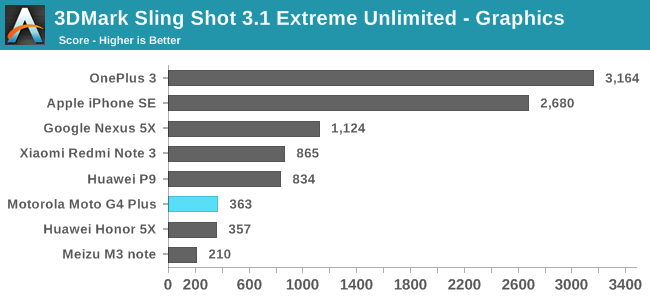
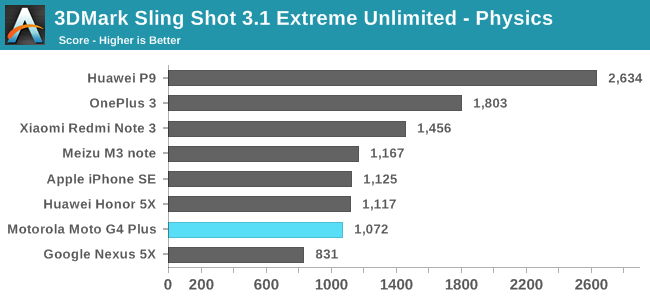
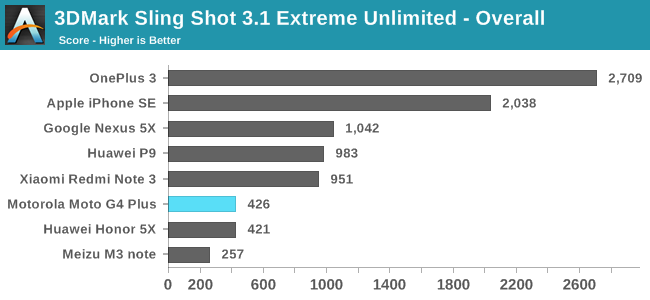
The 2015 Moto G doesn't support OpenGL ES 3.1, and so there's no way to run 3DMark Sling Shot Extreme Unlimited which uses ES 3.1 on Android and Metal on iOS. Snapdragon 617 uses the same Adreno 405 GPU as Snapdragon 615, and you can see in the results that the performance is right in line with the Huawei Honor 5X which uses Snapdragon 615. For a mid-range phone this is generally good performance, but once again the Xiaomi Redmi Note 3 sits far ahead of the rest of the mid-range smartphones, including the Moto G4.
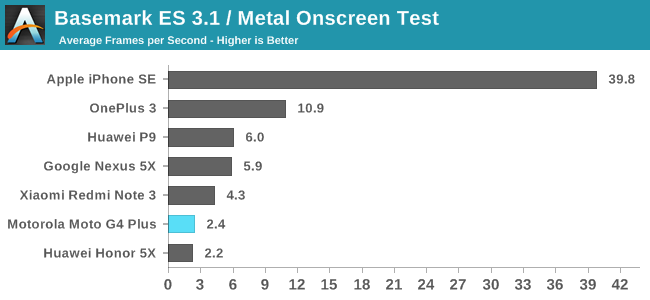
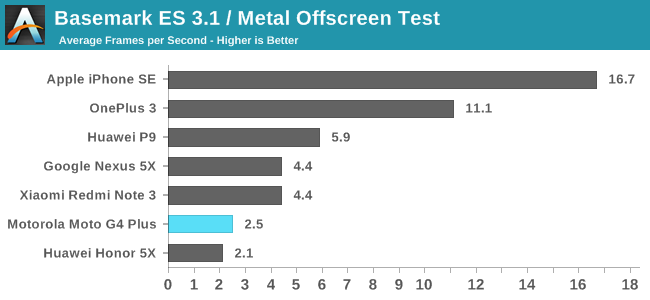
The situation in BaseMark ES 3.1 is the same as 3DMark, with the G4 Plus achieving roughly the same performance as the Huawei Honor 5X. The Xiaomi Redmi Note 3 with its Adreno 510 GPU ends up being a little over 75% faster, which is a huge improvement even if both devices technically don't get close to a playable frame rate in this very heavy test.
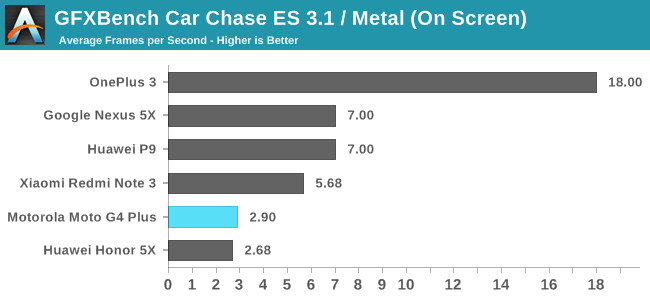
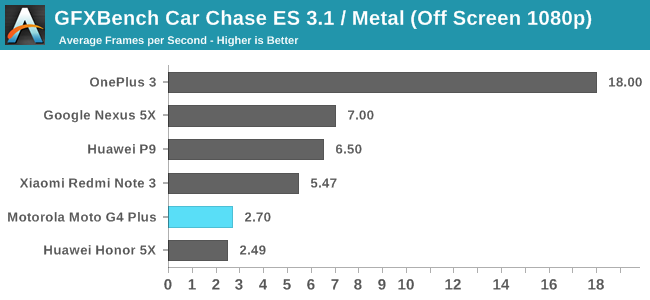
In GFXBench Car Chase it's the story is the same. The Moto G4 Plus is in line with other Adreno 405 devices, but the question is really whether or not that's good enough for a device launching this late into 2016.
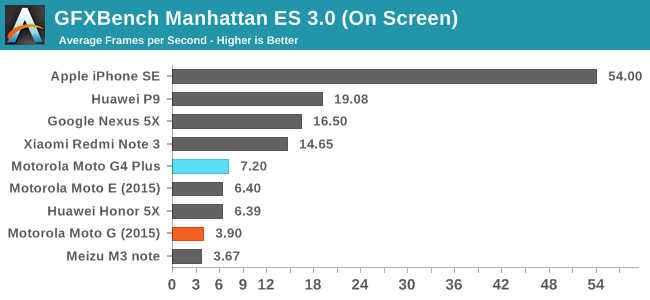
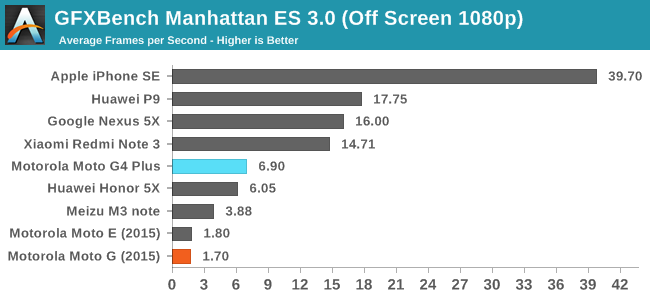
We've generally moved to Manhattan ES 3.1 / Metal for our reviews, but in cases like this where a device's predecessor doesn't support OpenGL ES 3.1 it's helpful to bring back Manhattan ES 3.0 to do a direct performance comparison. As expected, the Moto G4 is much faster than the 2015 Moto G, with on screen performance being about 85% faster despite the move from 720p to 1080p. and off screen performance being over four times faster.
It's clear that the Moto G4 provides much better GPU performance that the 2015 Moto G. However, much like the CPU benchmarks, I keep looking at the charts and seeing the Xiaomi Redmi Note 3 sitting well above the Moto G4. Adreno 405 is much better than Adreno 306, but Adreno 510 is two times faster than Adreno 405. I feel like the Moto G4 is simply launching too late for this kind of performance to be competitive, as it's tied with the Honor 5X which was launched at $200 nearly a year ago. While I don't mean to take away from the fact that the Moto G4 does provide faster GPU performance than its predecessor, I think there are devices right around the corner that are going to make a mid-range smartphone with Snapdragon 617 look decidedly last generation.
NAND Performance
NAND performance is still an area of concern on mid-range smartphones, but the situation has gotten better in recent times. The 2015 Moto E was an example of a device with very poor NAND performance, but the 2015 Moto G was significantly faster across the board. Motorola is still using eMMC memory, but there's definitely room for improvement over the 2015 Moto G even when sticking with an eMMC storage solution. To evaluate the Moto G4's storage performance I've run AndroBench 4.0 on both the 16GB Moto G4 and the 64GB Moto G4 Plus.
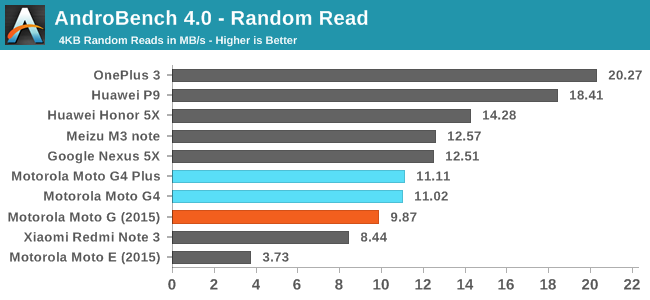
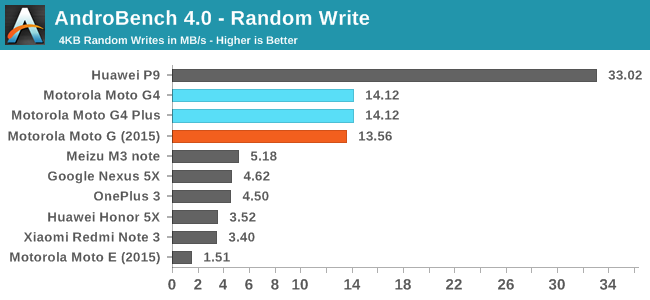
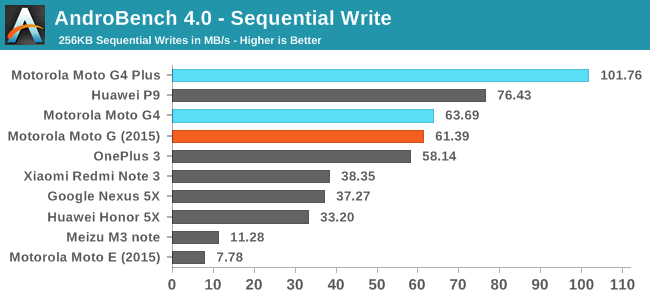

Among mid-range devices, the 64GB Moto G4 Plus performs very well. Random write results are ahead of all other devices on the chart except the Huawei P9, which isn't really a mid-range device and is just there for SoC comparisons. In the sequential write test the Moto G4 leads, which is due in part to the larger capacity allowing greater write parallelism. Sequential read performance is very good as well, although obviously not competitive with UFS 2.0 storage solutions like the one used in the OnePlus 3.










94 Comments
View All Comments
Barkuti - Monday, August 15, 2016 - link
Welcome to another member of the now ever increasing @#$% slabphone family, comprising in the following sizes to fulfill not so everyone's needs: mammoth, beluga, Moby-dick, Jahre Viking…For the love of God, @#$%!!!
Teknobug - Monday, August 15, 2016 - link
I'm somewhat interested in the G4 Plus, however it has an IPS display, kind of hard to go back to that after using an AMOLED for a long time. I still have my Moto X 2013 which is 4.7", the display is fantastic.WPX00 - Tuesday, August 16, 2016 - link
The dimmest display ever tested by phoneArena and among the dimmest according to AT, and also one of the brighest at lowest setting plus color rendering issues is fantastic?raju516 - Wednesday, August 17, 2016 - link
Moto x 2013 has good color calibration when compared to moto x 2014 which is worst. Also moto x 2013 dose not use pentile layout for its panel. However display is dim but I like itjb14 - Monday, August 15, 2016 - link
Thanks for the interesting review Brandon and well timed for me. I am looking for a phone under £200 after my trusty Samsung SII's WiFi finally failed this week. I've noticed in my search for a replacement that the Nexus 5x 16GB has now dropped to £200 (argos) so has now surprisingly joined the competition. It seems the 5x is a significant step up in most categories compared to these phones?cbf - Monday, August 15, 2016 - link
Brandon --I think you're doing a disservice to your readership by not covering Motorola's software update policies in your article, the ways Ars has: http://arstechnica.com/gadgets/2016/07/motorola-co...
I strongly advise my friends and family to avoid any vendors that aren't diligent about releasing Google's monthly security updates to Android -- which unfortunately, is just about all the Android OEMs. (Some, like Samsung, are pretty good for their flagship phones, but ignore most of their less expensive models.) Maybe if more journalists made this an important aspect of a review, we'd get better behavior from the OEMs (and yes, the carriers as well).
Otherwise, it's only Nexus phones for me and mine.
Lau_Tech - Monday, August 15, 2016 - link
Thanks for the good review Brandon! And timely as well.!I repeat my opinion: You and Matt Humrick should do the flagship phone reviews. Anandtech has had a very odd year where most of the flagship phone reviews are late and the entry-level phone reviews are not.
WPX00 - Tuesday, August 16, 2016 - link
Untrue about Samsung ignoring budget devices. I have a $150 Galaxy J2 that gets those updates once every so often, maybe not every month but once every 2 or 3. But then again you can say the same about my GS7's updates.aryonoco - Monday, August 15, 2016 - link
It would be great if Anandtech started to pay a little bit of attention to the Android Security Patch level that a device ships with as well.It should be noted that these phones are already well behind Google's monthly security patches, which mean that Motorola is selling devices with known remote root vulnerabilities, something that is definitely anti-consumer and borderline unethical in my opinion. Furthermore, Motorola has said that they won't be releasing monthly security updates. Their 2015 phones have also been very tardy in receiving Marshmallow, and have gotten security updates only very irregularly.
With all the attention to detail that AT pays to small details like the pixel size of the camera, I find it baffling how the update situation and how of timely security patches are completely ignored on this website.
Teknobug - Tuesday, August 16, 2016 - link
If this is true, then my concerns of Motorola getting sold to a Chinese firm was legit.